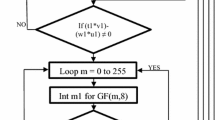Abstract
In this paper, we present a method to construct a substitution box used in encryption applications. The proposed algorithm for the construction of substitution box relies on the linear fractional transform method. The design methodology is simple, while the confusion-creating ability of the new substitution box is complex. The strength of the proposed substitution box is evaluated, and an insight is provided to quantify the confusion-creating ability. In addition, tests are performed to assess the vulnerability of the encrypted data to algebraic and statistical attacks. The substitution box is critically analyzed by strict avalanche criterion, bit independent criterion, differential approximation probability test, linear approximation probability test, non-linearity test, and majority logic criterion. The performance of the proposed substitution box is also compared with those of some of the well-known counterparts including AES, APA, Gray, S8, Skipjack, Xyi, and prime of residue substitution boxes. It is apparent that the performance, in terms of confusion-creating ability, of the new substitution box is better than those of some of the existing non-linear components used in encryption systems. The majority logic criterion is applied to these substitution boxes to further evaluate the strength and usefulness.






Similar content being viewed by others
References
Daemen J, Rijmen V (2002) The design of Rijndael- AES: the advanced encryption standard. Springer, Berlin
Cui L, Cao Y (2007) A new S-box structure named affine- power-affine. Int J Innov Comput I 3(3):45–53
Tran MT, Bui DK, Doung AD (2008) Gray S-box for advanced encryption standard. Int Conf Comp Intel Secur 1:253–256
Hussain I, Shah T, Mahmood H (2010) A new algorithm to construct secure keys for AES. Int J Cont Math Sci 5(26):1263–1270
Kim J, Phan RC-W (2009) Advanced differential-style cryptanalysis of the NSA’s skipjack block cipher. Cryptologia 33(3):246–270
Shi XY, Xiao Hu, You XC, Lam KY (2002) A method for obtaining cryptographically strong 8 × 8 S-boxes. Int Conf Infor Network Appl 2(3):14–20
Hussain I, Shah T, Mahmood H, Gondal MA, Bhatti UY (2011) Some analysis of S-box based on residue of prime number. Proc Pak Acad Sci 48(2):111–115
Matsui M (1994) Linear cryptanalysis method of DES cipher. Advances in cryptology, proceeding of the Eurocrypt’93, Lecture Notes in Computer Science 765:386–397
Feng D, Wu W (2000) Design and analysis of block ciphers. Tsinghua University Press, Beijing
Biham E, Shamir A (1991) Differential Cryptanalysis of DES-like Cryptosystems. Journal of Cryptology 4(1):3–72
Shah T, Hussain I, Gondal MA, Mahmood H (2011) Statistical analysis of S-box in image encryption applications based on majority logic criterion. Int J Phy Sci 6(16):4110–4127
Author information
Authors and Affiliations
Corresponding author
Rights and permissions
About this article
Cite this article
Hussain, I., Shah, T., Gondal, M.A. et al. A group theoretic approach to construct cryptographically strong substitution boxes. Neural Comput & Applic 23, 97–104 (2013). https://doi.org/10.1007/s00521-012-0914-5
Received:
Accepted:
Published:
Issue Date:
DOI: https://doi.org/10.1007/s00521-012-0914-5




